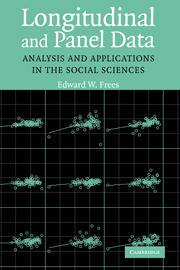Book contents
- Frontmatter
- Contents
- Preface
- 1 Introduction
- 2 Fixed-Effects Models
- 3 Models with Random Effects
- 4 Prediction and Bayesian Inference
- 5 Multilevel Models
- 6 Stochastic Regressors
- 7 Modeling Issues
- 8 Dynamic Models
- 9 Binary Dependent Variables
- 10 Generalized Linear Models
- 11 Categorical Dependent Variables and Survival Models
- Appendix A Elements of Matrix Algebra
- Appendix B Normal Distribution
- Appendix C Likelihood-Based Inference
- Appendix D State Space Model and the Kalman Filter
- Appendix E Symbols and Notation
- Appendix F Selected Longitudinal and Panel Data Sets
- References
- Index
Appendix F - Selected Longitudinal and Panel Data Sets
Published online by Cambridge University Press: 05 September 2012
- Frontmatter
- Contents
- Preface
- 1 Introduction
- 2 Fixed-Effects Models
- 3 Models with Random Effects
- 4 Prediction and Bayesian Inference
- 5 Multilevel Models
- 6 Stochastic Regressors
- 7 Modeling Issues
- 8 Dynamic Models
- 9 Binary Dependent Variables
- 10 Generalized Linear Models
- 11 Categorical Dependent Variables and Survival Models
- Appendix A Elements of Matrix Algebra
- Appendix B Normal Distribution
- Appendix C Likelihood-Based Inference
- Appendix D State Space Model and the Kalman Filter
- Appendix E Symbols and Notation
- Appendix F Selected Longitudinal and Panel Data Sets
- References
- Index
Summary
In many disciplines, longitudinal and panel data sets can be readily constructed using a traditional pre- and postevent study; that is, subjects are observed prior to some condition of interest as well as after this condition or event. It is also common to use longitudinal and panel data methods to examine data sets that follow subjects observed at an aggregate level, such as a government entity (state, province, or nation, for example) or firm.
Longitudinal and panel data sets are also available that follow individuals over time. However, these data sets are generally expensive to construct and are conducted through the sponsorship of a government agency. Thus, although the data are available, data providers are generally bound by national laws requiring some form of user agreement to protect confidential information regarding the subjects. Because of the wide interest in these data sets, most data providers make information about the data sets available on the Internet.
Despite the expense and confidentiality requirements, many countries have conducted, or are in the process of conducting, household panel studies. Socio-demographic and economic information is collected about a household as well as individuals within the household. Information may relate to income, wealth, education, health, geographic mobility, taxes, and so forth. To illustrate, one of the oldest ongoing national panels, the U.S. Panel Study of Income Dynamics (PSID), collects 5,000 variables. Table F.1 cites some major international household panel data sets.
- Type
- Chapter
- Information
- Longitudinal and Panel DataAnalysis and Applications in the Social Sciences, pp. 445 - 450Publisher: Cambridge University PressPrint publication year: 2004
- 1
- Cited by



